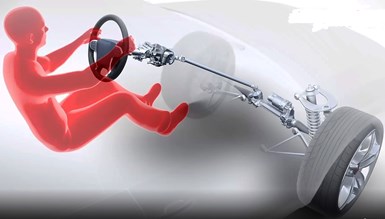Steering to the Future
Electric power steering systems have come a long way in a short time. Are steer-by-wire systems next?
Electric power steering systems, which debuted 20 years ago, now are fitted on virtually every new car and light truck. The reason is simple: EPS can boost fuel efficiency by as much as 6% over previous hydraulic-based power steering-assist systems.
The technology also provides the basis for a variety of other emerging safety systems. EPS already is being used in advanced driver-assistance systems (ADAS), such as lane-keeping assist, parking aids and traffic-jam assist, notes Jeff Zuraski, executive director of research and development for Nexteer Automotive.
The Michigan-based supplier, which pioneered the technology in 1999, makes about 10 million EPS units per year. Now the company is preparing for the next level, including long-awaited steer-by-wire systems (SbW).
By-Wire Benefits
With SbW, the mechanical connection between the steering wheel and road wheels is replaced with electronics and actuators on the steering column and rack to enhance stability, reduce weight and improve packaging flexibility. Engineers have been developing the technology for decades, but cost, reliability and consumer acceptance issues have thwarted commercialization.

Steer-by-wire systems promise to improve performance, reduce weight and enable greater packaging flexibility. (Image: Nexteer)
But Zuraski says recent software improvements and other advances—including more sophisticated sensors, backup processors and other redundancies—could soon make SbW feasible.
Part of the challenge has been how to convey the same road feedback with the electronic system that drivers get with a mechanical connection. Drivers need to quickly discern changes in road conditions, such as the differences between driving on dry and wet pavement, so they can make the necessary adjustments to optimize safety.
Nexteer’s SbW technology uses ADAS sensors to monitor road conditions, then emulates the “feel of the road” back to the driver through torque feedback on the steering wheel generated by a small motor added to the column and steering wheel assembly. “The feel has to be right or drivers won’t accept it,” Zuraski stresses.
Next-Gen Value
The rapid growth of EPS and ADAS has helped bring the costs of the technologies down. The next step is to add features and functionality, such as programmable steering ratios, automatic emergency steering and integrated braking functions.
A handful of vehicles currently use variable steering ratios based on vehicle speed to enable greater maneuverability at low speeds and enhanced stability at higher speeds. SbW makes this easier to do and could provide a greater performance range—from sporty to luxury—according to Nexteer.
Similar to automatic emergency braking, emergency steering would temporarily take control of a vehicle to prevent an imminent collision. The system could be designed to limit maneuvers within a lane or, working in tandem with other sensors, automatically change lanes if a path is clear. While the technology can be added to current EPS, Zuraski says SbW provides greater benefits because it allows the road wheels to be moved without rotating the steering wheel, thus minimizing counteractive driver inputs.
Meanwhile, Nexteer’s 3-year-old CNXMotion joint venture with Continental is developing integrated “motion control” systems. The goal is to better coordinate braking and steering inputs to enable highly automated driving systems through control and actuator systems. Integrating the functions enables the best balance between the finite steering and braking forces available at each wheel, Zuraski notes.
Nexteer also is developing systems to smooth the transition between semi- and fully autonomous vehicles. This includes a system that automatically retracts the steering wheel when the vehicle is operating in autonomous mode, and one that prevents the steering wheel from rotating to minimize driver distraction.

